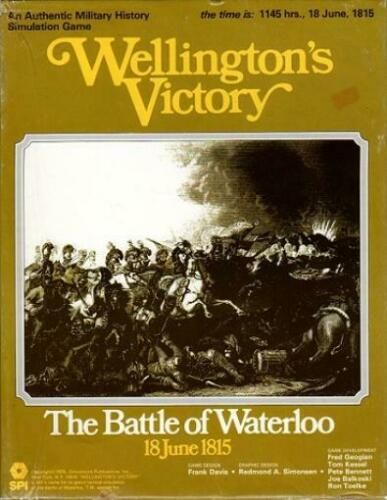Wellington’s Victory: Battle of Waterloo Game – June 18th, 1815 (1976) Board Game
Brief History and Background Information for Wellington’s Victory: Battle of Waterloo Game – June 18th, 1815
Wellington’s Victory: Battle of Waterloo Game – June 18th, 1815 is a historical wargame designed by Frank Davis and published by SPI in 1976. The game is set during the famous Battle of Waterloo, which took place on June 18th, 1815, between the forces of Napoleon Bonaparte and the Duke of Wellington. Players take on the roles of these military leaders as they strategize and command their troops in this pivotal battle.
Game Components of Wellington’s Victory: Battle of Waterloo Game – June 18th, 1815
- Hexagon Grid game board
- Rulebook
- Counters representing military units
- Combat Results Table
- Dice
How To Setup Wellington’s Victory: Battle of Waterloo Game – June 18th, 1815
- Place the game board on a flat surface.
- Place the counters representing military units on their designated starting positions.
- Refer to the rulebook for any additional setup instructions.
Gameplay Mechanics and Game Objective
Wellington’s Victory is a wargame that uses a Hexagon Grid and a Ratio/Combat Results Table to simulate the strategic and tactical decisions made during the Battle of Waterloo. The objective of the game is to either defeat your opponent’s forces or achieve specific victory conditions based on historical outcomes.
Player Experience
Pros:
- Detailed historical accuracy in terms of units and terrain
- Engaging strategic decision-making
- Provides a deeper understanding of the Battle of Waterloo
Cons:
- Steep learning curve for new players
- Lengthy gameplay time of approximately 4 hours
- Requires a dedicated opponent for 2-player gameplay
Personal Thoughts on Wellington’s Victory: Battle of Waterloo Game – June 18th, 1815
Wellington’s Victory is a classic wargame that offers a deep dive into the historical events of the Battle of Waterloo. The game’s components are well-designed, and the gameplay mechanics provide a challenging and immersive experience for players interested in Napoleonic warfare. However, the lengthy gameplay time and complexity may not appeal to casual gamers. Overall, Wellington’s Victory is worth considering for history buffs and wargame enthusiasts who enjoy in-depth strategic gameplay.
In terms of pricing and availability, Wellington’s Victory may be harder to find as it was released in 1976. However, used copies can sometimes be found online through platforms like eBay or board game marketplaces. For those looking for alternatives, similar wargames like “Napoleon: The Waterloo Campaign, 1815” or “Waterloo: Enemy Mistakes – The Campaign of 1815” offer comparable experiences.
In conclusion, Wellington’s Victory: Battle of Waterloo Game – June 18th, 1815 is a niche wargame that appeals to a specific audience of history enthusiasts and strategic gamers. If you have the time and dedication to delve into the complexities of Napoleonic warfare, this game may be a worthwhile addition to your collection.
Game Components of Wellington’s Victory: Battle of Waterloo Game – June 18th, 1815
How To Setup Wellington’s Victory: Battle of Waterloo Game – June 18th, 1815
Setting up the game involves several steps. First, the large hex map is laid out, which represents the seven-mile battle front with 100 yards per hex. Players then deploy their units according to the provided deployment charts. The French, Anglo-Allied, and Prussian forces are positioned on the map, with each unit represented by a specific counter. The game includes various formation markers and leader counters that need to be placed accurately to reflect the historical setup of the battle.
Gameplay Mechanics and Game Objective
Player Experience
Playing **Wellington’s Victory** is a deeply immersive and complex experience. The game demands serious commitment and concentration due to its large number of counters and intricate rules. Players must strategically deploy their units, utilize various formations and tactics, and manage their resources carefully. The game captures the historical tension and pressure felt by the commanders during the Battle of Waterloo, making it a classic among wargamers.
Pros
Cons
Personal Thoughts on Wellington’s Victory: Battle of Waterloo Game – June 18th, 1815
**Wellington’s Victory** is ideal for experienced wargamers who appreciate detailed historical simulations. It is not a game for casual players due to its complexity and the time required to learn and play it. However, for those who are willing to invest the time, it offers a rich and rewarding experience that closely replicates the strategic challenges and historical context of the Battle of Waterloo. If you are fascinated by the Napoleonic Wars and enjoy deep strategic gameplay, **Wellington’s Victory** is a must-play.
We are supported by our audience. When you purchase through links on our site, we may earn an affiliate commission, at no extra cost for you. Learn more.

